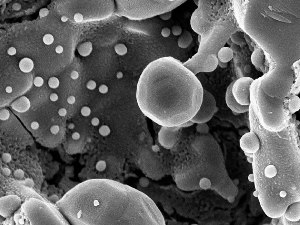Apr 28 2014
Fuel cells have long been heralded as the energy technology of the future. Invented in 1838, the cells promise an almost limitless supply of clean energy for everything from cars to electrical grids, but have always proven too expensive to manufacture, fuel and maintain to enter mainstream use. Hoping to bring down those costs, a team of Bucknell faculty and student researchers has developed a new tool that could greatly accelerate fuel cell experimentation, and one day lead to the first commercially viable fuel cells.
 These scanning electron microscope images provided by Michael Gross show catalysts clinging to conductive materials inside a fuel cell.
These scanning electron microscope images provided by Michael Gross show catalysts clinging to conductive materials inside a fuel cell.
The tool developed by professors Michael Gross and Ryan Snyder, chemical engineering, with a team of four students, is a computer program to model fuel cell electrodes and predict what happens when engineers use different components to build them. Gross, a fuel cell engineer, and researchers like him will employ the program to quickly simulate the time-consuming task of building and testing prototype cells.
"I know a lot about fuel cells, and through experience I've gained an intuition for what matters, but I need to quantify and communicate that to people," Gross said. "I can do it experimentally but it's slow. If I could make it faster, the impact would be much greater."
"The kinds of experiments we're doing really will help shape the way fuel cells are made, run and optimized in the future," said Mike Synodis '13, a chemical engineering graduate who spent more than two years programming and testing the modeling tool. "The end goal of all this is to attack some of the problems our society is facing."
Other researchers have taken notice, not only of the project's lofty goals, but of its practical potential for accelerating experimentation. Energy science and trade publication Renewable Energy Global Innovations named the Bucknell researchers' paper describing the program a Key Scientific Article for Progress and Innovation in Renewable Energy Research.
"The benefit of doing a model is not only to look at the range of parameters you typically would examine in the lab, but also to do things that you don't typically try to do," Snyder said. "If the model says we're 10 times more efficient if we operate under a totally different condition than we thought about before, then it's worth putting effort into trying to do that in the lab."
Fuel cells require greater refinement, Gross added, because they require expensive components and maintenance. The cells produce power by combining oxygen with a fuel — Gross focuses on hydrocarbons, but hydrogen and alcohol are also used — in chemical reactions that release electricity. But to create those reactions, current generation hydrocarbon fuel cells must operate at intense temperatures of up to 900 degrees Celsius. These temperatures force manufacturers to build fuel cell electrodes using either costly rare earth metals that can handle the heat or cheaper materials that degrade quickly.
"All of the problems holding back this fuel cell technology relate back to this very high operating temperature," Gross said. "We're trying to develop materials and composites that can efficiently work at lower temperatures to mitigate the degradation issues and the high cost of these exotic materials."
Though they've been put to use everywhere from NASA spacecraft to the corporate offices of Google, eBay and Wal-Mart, Gross said fuel cells will not become a mainstream power source until they can compete unsubsidized with conventional power sources.
"Green technology sounds nice, but until it reaches the point of affordability, there won't be widespread commercialization," Gross said.
The researchers said they will continue refining their modeling software, though they admit that the first truly commercially viable fuel cells will be a larger effort requiring the work of many more scientists from around the world. Even their software, the Bucknell researchers said, was a truly collaborative effort.
"Neither one of us could have done this on our own," said Snyder, whose expertise is not in fuel cells but in computer simulation. "It was our working together that made it happen."
The student researchers too played an active role, developing and encoding most of the program, and co-authoring the paper describing it.
"It really felt like it was mine," Synodis said. "They had come up with the idea, but we built the whole thing from the ground up. It was nice to be a part of a partnership with professors rather than just being taught or told what to do."